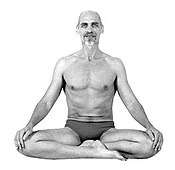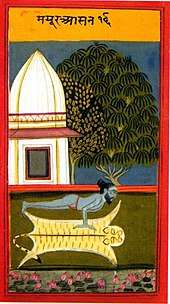Siddhasana
Siddhasana (Sanskrit: सिद्धासन; IAST: siddhāsana) or Accomplished Pose, is an ancient seated asana in hatha yoga and modern yoga as exercise suitable for meditation.[1] The name Muktasana (Sanskrit: मुक्तासन, Liberated Pose) is sometimes given to the same pose, sometimes to an easier variant.
Etymology and origins
The name comes from the Sanskrit words siddha (सिद्ध) meaning both "perfect" and "adept",[2] and asana (आसन) meaning "posture" or "seat".[3] The name Muktasana comes from मुक्त mukta meaning "liberation".[4][5] Ann Swanson writes that the pose is called accomplished as it was the goal of all other asanas to ready the body to sit in meditation in this way.[6] In Light on Yoga, B. K. S. Iyengar quotes several scriptures, stating that the yogin who contemplates Atman and practises Siddhasana for 12 years obtains the yoga siddhis, supernatural powers; and that once the pose is mastered, samadhi follows "without effort".[7]
Siddhasana is one of the oldest asanas, being described as a meditation seat in the 10th century Goraksha Sataka 1.10-12. The Hatha Yoga Pradipika praises the asana, implying it is the only one that practitioners would need, asking "When siddhasana is mastered, of what use are the various other postures?"[8]
Description
From a seated position, one heel is brought to press on the perineum with the sole of the foot flat against the inner thigh. The body sits on top of this heel. Adjustments are made until the body is comfortable and the pressure is firmly applied. Then the opposite ankle is placed over the first, so the ankle bones are touching and the heels are above one another with the top heel pressing the pubis directly above the genitals. The genitals will then lie in between the two heels. The toes and outer edge of the top foot are pushed down into the space between the calf and thigh muscles. The toes of the bottom foot are pulled up into the similar space on the opposite side. The spine is held erect. A small meditation cushion or zafu is sometimes used to help align the back vertically.[9] The same pose for women is sometimes called Siddha Yoni Asana.[10]
Variations
Muktasana, Liberation Pose, is either exactly the same as Siddhasana, as stated in the 15th century Hatha Yoga Pradipika, or a variant with the feet close in to the perineum but resting on the ground.[5] This variant is sometimes called Ardha Siddhasana (Sanskrit अर्ध ardha, half).[11]
Sukhasana, Easy Pose, has the legs crossed at mid-calf. The pose can be supported by sitting on a cushion.[6]
 Siddhasana in the 19th century Jogapradipika; the yogin is meditating on a tiger skin
Siddhasana in the 19th century Jogapradipika; the yogin is meditating on a tiger skin.jpg) Statues of Buddha at Gangaramaya Temple
Statues of Buddha at Gangaramaya Temple Muktasana, an easier variant with the feet on the ground, also used for meditation
Muktasana, an easier variant with the feet on the ground, also used for meditation
Usage
Siddhasana and Padmasana (Lotus Pose) are traditionally used for dhyana (meditation) and pranayama (breath exercises).[7][12] Sukhasana (Easy Pose) and Muktasana (with both knees and both feet on the floor) are easier alternatives.
References
- "Witold Fitz-Simon - Siddhasana (Accomplished Pose)". Retrieved 4 July 2011.
- Feuerstein, Georg; Payne, Larry (5 April 2010). Yoga For Dummies. For Dummies. p. 92. ISBN 978-0-470-50202-0.
- Sinha, S. C. (1 June 1996). Dictionary of Philosophy. Anmol Publications. p. 18. ISBN 978-81-7041-293-9.
- "Pavana Muktasana". The Yoga Tutor. Retrieved 23 November 2018.
- "Muktasana". Yogapedia. Retrieved 23 November 2018.
- Swanson, Ann (2019). Science of yoga : understand the anatomy and physiology to perfect your practice. New York, New York: DK Publishing. p. 46. ISBN 978-1-4654-7935-8. OCLC 1030608283.
- Iyengar, B. K. S. (1979) [1966]. Light on Yoga. Thorsons. pp. 116–120.
- Feuerstein, Georg (22 March 2011). The Path of Yoga: An Essential Guide to Its Principles and Practices. Shambhala Publications. p. 63. ISBN 978-1-59030-883-7.
- Swami Satyananda Saraswati (1996). Asana Pranayama Mudra Bandha (PDF). Yoga Publications Trust. p. 100. ISBN 978-81-86336-14-4.
- Swami Satyananda Saraswati (1996). Asana Pranayama Mudra Bandha (PDF). Yoga Publications Trust. p. 102.
- Maehle, Gregor (2011). Ashtanga Yoga: Practice and Philosophy. New World Library. p. 57. ISBN 978-1-57731-986-3.
- Upadhyaya, Rajnikant; Sharma, Gopal (1 January 2006). Awake Kundalini. Lotus Press. p. 54. ISBN 978-81-8382-039-4.
_from_Jogapradipika_1830_(detail).jpg)

